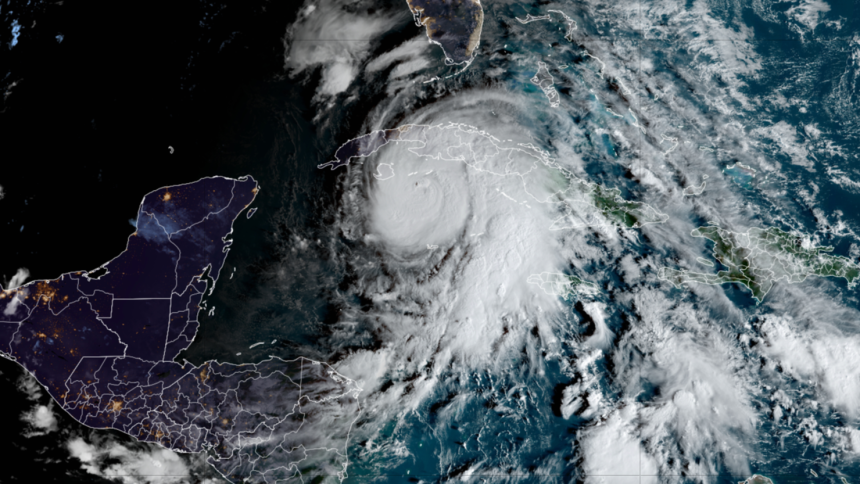CNN
—
Hurricane Rafael is rapidly intensifying in the Caribbean and is expected to become a Category 3 hurricane before it slams into Cuba Wednesday.
As of Wednesday morning, Rafael was a Category 2 storm with winds of 110 mph – just 1 mph away from Category 3 status – and 130 miles from Cuba.
The storm’s winds have strengthened by 50 mph in the past 24 hours, an increase well over the 35 mph needed for rapid intensification. Rapid intensification is happening more frequently as the atmosphere and oceans warm due to fossil fuel pollution; Rafael is the ninth storm to rapidly intensify in the Atlantic basin this year.
After it tears through the Caribbean, the powerful hurricane is expected to face some serious resistance in the Gulf of Mexico and could make landfall as a much weaker storm this weekend anywhere from the US Gulf Coast to northeastern Mexico.
What, if any, threat Rafael poses to the Gulf Coast is still unclear but is coming into better focus, and a more confident forecast will be possible once the storm is in the Gulf Thursday.
Rafael’s threat to Cuba is clear: It’s expected to deliver a devastating blow as the first Category 3 hurricane to hit the country since Ian in 2022.
Heavy rain from the hurricane was spreading across Cuba Wednesday morning and will deluge the country into Thursday. Double-digit rainfall totals are possible. Tropical storm-force wind gusts were just off the country’s southern coast early Wednesday. Those winds and stronger hurricane-force winds will overspread Cuba over the next several hours.
Rafael’s powerful winds were also churning up dangerous seas and could produce up to 13 feet of storm surge for Cuba’s southern shore ahead of landfall.
This is the second blow from a hurricane in Cuba in recent weeks. Hurricane Oscar walloped Cuba in late October, killing at least 6 people. The country’s power grid is also vulnerable and has collapsed multiple times, including when Oscar hit in October.
Rafael could become the fifth major hurricane – one that is Category 3 or stronger – of the season. It is the strongest hurricane to roam the northwestern Caribbean in November since 2009, according to data from the NOAA.
It’s forecast to become only the fifth hurricane to roam the Gulf of Mexico in November since 1966, according to hurricane expert Michael Lowry.
Rafael’s future track is uncertain
Rafael’s potential track through the Gulf of Mexico later this week and over the weekend is slowly coming into focus but is far from certain.
Rafael could still become the sixth named storm to slam into the US this season, but the areas at risk are gradually being narrowed down.
Earlier in the week, forecast models depicted very different possible paths for Rafael, but these models have started to converge on a solution. Instead of a steady track to the northwest over the Gulf and a landfall along the northern Gulf Coast, two major forecast models are more consistently showing a significant shift to the west.
The current forecast from the hurricane center indicates Rafael could potentially impact anywhere from Louisiana to northeastern Mexico, west of initial forecasts that had Alabama and the Florida Panhandle at risk.
“If future model runs continue to show this trend… additional leftward adjustment to the NHC track may be required,” the center said Wednesday.
Storm-disrupting upper level winds are likely to severely deteriorate Rafael the closer the storm gets to the US coastline, regardless of where that is. Current forecasts call for Rafael will return to tropical storm status by the weekend.
Rafael’s US impacts could be limited, but the same robust tropical moisture fueling the storm Wednesday will fuel torrential rainfall for the Southeast.
A widespread area of level 2 of 4 risk of flooding rainfall is in place Wednesday for parts of South Carolina, Georgia and Alabama, according to the Weather Prediction Center. Smaller portions of Georgia and South Carolina are under a level 3 of 4 risk of flooding rainfall.
Bursts of rain could cause dangerous flash flooding, but some areas could be slow to flood given how dry a lot of the soils are after a record-breaking October.
CNN’s Brandon Miller, José Álvarez, Patrick Oppmann and Michael Rios contributed to this report.


